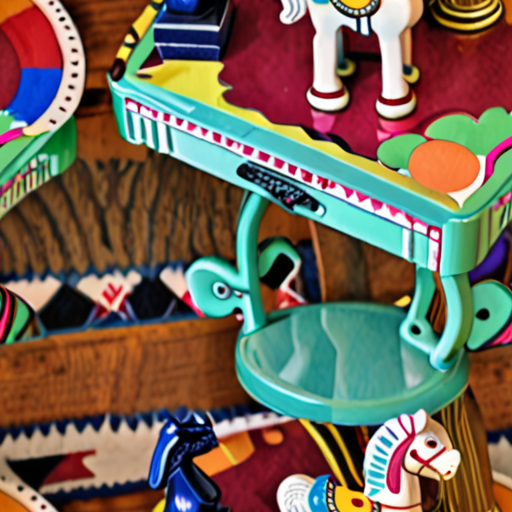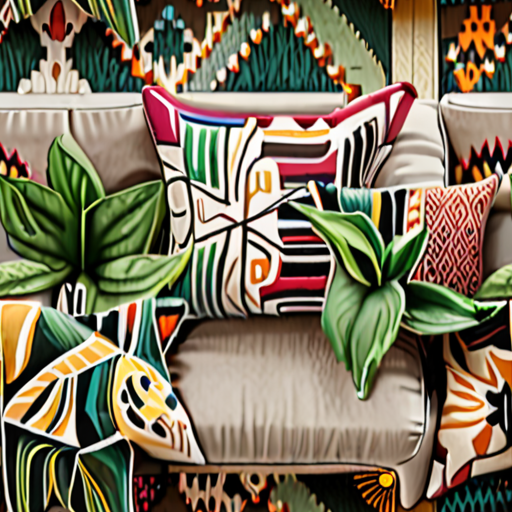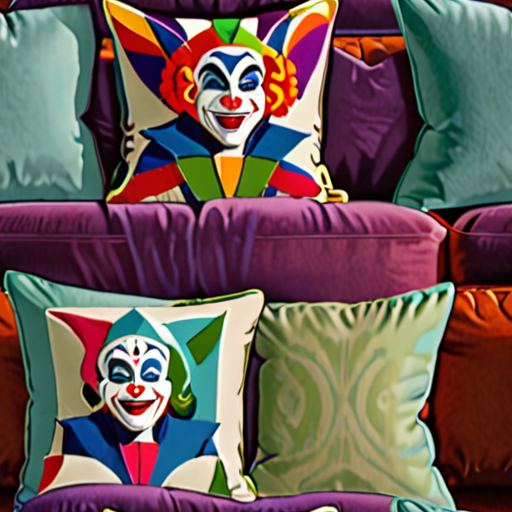Laughter is indeed the best medicine, but did you know it can also be the secret ingredient to creating a truly unique and inviting space? Adding humor to decor is a clever way to inject personality into your home, making it feel more like a reflection of who you are and less like a generic showroom. By incorporating quirky touches, playful patterns, and whimsical artwork, you can turn your living room into a laughter-filled haven that’s sure to put a smile on everyone’s face.

Adding Personality to Decor
When it comes to decorating your home, adding personality is all about reflecting your unique style and tastes.
- Create a space for your mementos: Adorn your home with personal objects and keepsakes, such as photographs, family heirlooms, or souvenirs, which not only add character but also evoke emotions and create a sense of connection to the space.
- Experiment with bold colors and patterns: Incorporate vibrant hues and eclectic patterns through furniture, rugs, or artwork to inject energy and visual interest into your decor.
- Incorporate statement pieces: Add a show-stopping piece of art, a vintage find, or a unique decorative item that reflects your personality and adds a touch of whimsy to your space.
- Make it personal with textiles: Use throw pillows, blankets, or a statement rug to incorporate personal touches and add texture to your decor.
- Don’t forget about scents: Infuse your space with your favorite fragrances through candles, essential oils, or room sprays to create a sensory experience that’s uniquely yours.
Remember, adding personality to your decor is all about expressing yourself and making your space feel truly yours.
Tips for Unique Interiors
- Start with a focal point: Choose a statement piece or a bold color scheme to draw attention and set the tone for your space.
- Mix and match styles: Combine different textures, patterns, and eras to create a visually interesting and eclectic look.
- Don’t be afraid to take risks: Try out new ideas and experiment with different layouts until you find a configuration that feels authentic to you.
- Make it functional: Balance aesthetics with functionality by incorporating multi-purpose furniture or clever storage solutions.
- Have fun: Decorating your home should be an enjoyable process, so don’t stress too much about perfection – focus on creating a space that makes you happy!
Creating a Space That Reflects Your Personality
By incorporating personal touches, experimenting with bold colors and patterns, and making thoughtful design choices, you can create a space that truly reflects your unique personality and style.
Decorating Tastefully
When it comes to decorating your space, there are several factors to consider to achieve a look that is both aesthetically pleasing and functional.
- Start with a Clear Vision: Before beginning your decorating project, take some time to think about what style and atmosphere you want to create in your space. Consider your personal preferences, lifestyle, and the purpose of each room.
- Choose a Color Scheme: Select a color palette that reflects your vision and complements the natural lighting in your space. Consider the mood and emotions you want to evoke in each room.
- Select Furniture and Decor: Choose furniture pieces and decorative items that fit your chosen style and color scheme. Consider the scale, proportion, and functionality of each piece.
- Add Texture and Pattern: Mix different textures and patterns to add depth and visual interest to your space. Consider combining smooth surfaces with rough textures and bold patterns with subtle ones.
- Incorporate Plants: Adding plants to your space can bring in a touch of nature and freshness. Choose low-maintenance plants that fit your lifestyle and style.
- Consider Lighting: Proper lighting can greatly impact the ambiance of your space. Use a combination of overhead lighting, table lamps, and floor lamps to create a warm and inviting atmosphere.
- Don’t Forget About Accessories: Add decorative accessories such as artwork, rugs, and throw pillows to complete your look and add personality to your space.
Tips for Creating a Cohesive Look
- Stick to a Unifying Theme: Choose a theme or style that ties everything together and creates a sense of cohesion in your space.
- Use a Neutral Background: A neutral-colored background can provide a clean canvas for adding pops of color and texture through furniture and decor.
- Balance Bold Pieces: If you have a statement piece or bold pattern, balance it out with simpler, more understated elements to prevent overwhelming the senses.
- Play with Scale: Mixing large and small pieces can create visual interest and add depth to your space.
Final Touches
Once you’ve selected your furniture, decor, and accessories, it’s time to add the final touches. Consider adding a few well-placed mirrors to create the illusion of more space and add light to dark corners. Finally, step back and evaluate your space to ensure it feels cohesive and reflective of your personal style.

Make Your Room Creative
I’m always looking for ways to make my space feel more me, and I’ve learned a thing or two about how to turn a dull room into a vibrant oasis.
- Add Colorful Accents: Throw pillows, blankets, and rugs can instantly add a pop of color to your room. Try pairing bold hues with neutrals for a balanced look.
- Get Creative with Lighting: Table lamps, floor lamps, and string lights can add ambiance and create cozy nooks. Experiment with different light fixtures to find the perfect combination.
- Showcase Personal Treasures:
- Display Artwork and Prints: Hang your favorite pieces of art or prints on the walls to add visual interest and personality to your space.
- Bring in Plants: Greenery can purify the air and add a touch of nature to your room. Choose low-maintenance plants like succulents or air plants for easy care.
- Use Textiles to Add Texture: Throws, blankets, and rugs can add depth and texture to your space. Mix and match patterns and textures to create a visually interesting look.
Remember, making your room creative is all about expressing yourself and having fun with the process. Don’t be afraid to experiment and try new things – it’s okay to make mistakes!
Some of My Favorite Resources Include:
- HGTV for inspiration and decorating ideas
- Pinterest for discovering new styles and trends
- Amazon for finding unique decorative items and furniture
Happy Decorating!

Where to Start When Decorating a Living Room
When decorating a living room, it can be overwhelming to decide where to begin.
- Start with a focal point, such as a statement piece of art, a vibrant area rug, or a bold wallpaper design.
- This will give you a foundation to build upon and make it easier to choose complementary colors and patterns for the rest of the room.
- Consider the overall style and atmosphere you want to create in your living room, and let that guide your choices for furniture, lighting, and accessories.
- Think about the functionality of the space and how you plan to use it – will it be a cozy reading nook, a family gathering place, or a entertainment hub?
- Once you have a clear idea of what you want to achieve, you can start selecting pieces that fit your vision and budget.
- Don’t forget to consider the 60-30-10 rule, which suggests allocating 60% of your budget to essential items, 30% to secondary items, and 10% to decorative accents.
- This will help you strike a balance between functionality and aesthetics and ensure that your living room feels cohesive and inviting.
- Finally, remember to have fun and be patient – decorating a living room is a process, and it may take some trial and error to get it just right.
By following these steps and considering your personal style and needs, you’ll be well on your way to creating a beautiful and functional living room that reflects your personality and enhances your daily life.
In What Order Do You Decorate a Living Room?
To create a beautiful and inviting living room, it’s essential to have a plan in place before you start decorating.
- Step 1: Plan Your Layout
- Step 2: Choose a Color Scheme
- Step 3: Select Furniture
- Step 4: Add Lighting
- Step 5: Accessorize
- Step 6: Final Touches
Determine the purpose of your living room and how you want to use the space. Consider the size and shape of the room, as well as the location of doors and windows.
Select a color scheme that reflects your personal style and complements the room’s architecture. Consider the mood and atmosphere you want to create in the space.
Pick furniture pieces that fit your budget and complement your chosen color scheme. Consider the function and comfort of each piece, as well as its aesthetic appeal.
Incorporate a mix of lighting sources, including overhead lighting, table lamps, and floor lamps, to create a warm and inviting ambiance.
Add decorative accessories, such as rugs, throw pillows, and wall art, to bring personality and style to the space.
Add any finishing touches, such as plants, vases, or sculptures, to complete the look and feel of your living room.
By following these steps, you can create a beautifully decorated living room that reflects your personal style and provides a comfortable and inviting space for relaxation and entertainment.

The Principles of Interior Decorating
As someone who loves to express my personality through my living space, I’ve always been fascinated by the art of interior decorating.
-
Balance
Creating a balanced look involves striking a harmony between different elements such as color, texture, and pattern. To achieve this, consider the visual weight of each element and distribute it evenly throughout the room.
-
Unity
Unity refers to the sense of cohesion and consistency in a room’s design. This can be achieved through the use of a common theme, color scheme, or style.
-
Rhythm
Rhythm in interior decorating refers to the repetition of certain elements such as patterns, textures, or colors to create a sense of movement and energy in a room.
-
Emphasis
Emphasis is used to draw attention to a particular feature or focal point in a room. This can be achieved through the use of bold colors, statement pieces of furniture, or dramatic lighting.
-
Contrast
Contrast is used to create visual interest and depth in a room by combining different elements such as light and dark colors, smooth and textured surfaces, or cool and warm tones.
-
Scale and Proportion
Scale and proportion refer to the relationship between the size of objects and the space they occupy. To create a harmonious look, ensure that the scale and proportion of furniture and decorative items are proportional to the room.
-
Details
Attention to detail is crucial in interior decorating. Consider the small touches such as hardware, lighting fixtures, and accessories that can make or break the overall aesthetic of a room.
In addition to these principles, there are several other factors to consider when designing a beautiful and functional space. These include:
-
Color Theory
Understanding how colors interact with each other is essential in creating a harmonious palette. Consider the 60-30-10 rule, which suggests dividing a room into 60% dominant color, 30% secondary color, and 10% accent color.
-
Furniture Selection
Picking the right furniture can make or break the look of a room. Consider the function, comfort, and style of each piece, as well as its relationship to the surrounding space.
-
Lighting Design
Lighting can greatly impact the ambiance and functionality of a room. Consider the type, placement, and intensity of lighting to create a warm and inviting atmosphere.
By considering these principles and factors, you’ll be well on your way to creating a beautiful and functional space that reflects your personality and style.
Conclusion
Interior decorating is an art form that requires patience, creativity, and attention to detail. By understanding the principles of balance, unity, rhythm, emphasis, contrast, scale and proportion, and details, you’ll be able to create a space that is both aesthetically pleasing and functional. Remember to consider color theory, furniture selection, and lighting design to take your space to the next level.

0 Comments